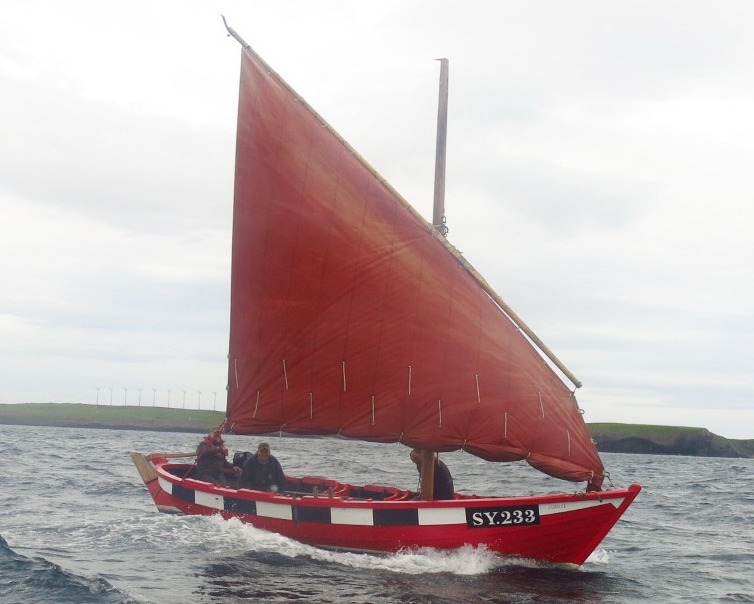Ideally suited to fishing in Scottish coastal waters, working in the North Atlantic can be unpredictable, with danger never far away for fishermen seeking whitefish from the long-line ‘sgoth Niseach’. These clinker built skiffs, peculiar to the Ness area of northern Lewis, off the west coast of Scotland could not compete with steam-powered vessels and only one remains today, SY233 ‘Jubilee’.
For Atlantic fishing a large decked boat would be required, not less than 46′ in keel, 56 – 60′ overall, beam from 16 – 18′, lug-rigged foremast to lower, foresail dipping lug when at sea, which could be converted into standing or balance lug when working into harbour. These boats could be used for long-line, hand-line and drift-net fishing, the lines being worked by the boats, or in fine weather, each large boat might carry two or more small boats to work extra sets of long lines. These large boats should have capstan or winch with steam anchor, with a length of chain and long hawser for anchoring in deep water. Open boats of 24′ carrying 4 or 5 hands could be used near the stations and on the inner side of the Long Island, and 4-oared whale boats could be used for the sun-fishing and might be carried or towed out by the larger boats. The decked boats would cost £300; 24′ skiffs, £25; 25′ whale boats, £23.
Captain Thomas A. Dymes RN, 1883 Report for Napier Highlands and Islands Commission
We were very interested to see the little open lugger, Sgoth with her crew mastering the intricacies of sailing with a dipping lug. Non-sailing readers only need to know that the dipping lug rig is fast but sadly is almost obsolete as the rig is difficult to handle and needs a large skilled crew. For this reason in the days of sail the lug rig used to be popular with smugglers and pirates and with those whose job it was to catch them. The picture shows the little lugger going well.
Mike Beckett, 2013 from the log of ‘Bonita’
Ness, at the northernmost point of the Isle of Lewis, was an important fishing station for whitefish in the 19th and early 20th century. The fishermen, mainly croft tenants, couldn’t afford the vessels outlined by Captain Dymes and besides, there were few natural harbours to accommodate such large craft. They used small open boats catching ling and cod on baited long-lines. Wading into the surf to launch and land their boats, the men were often helped by their wives who carried them through the surf to keep their clothing dry as they set out to sea, often for two days at a time. With steep cliffs and few quays on the shoreline, the women then carried the catch to the curing sheds in creels on their backs. The fishermen of Ness developed a sturdy, manoeuvrable vessel to serve their needs. Known as the Ness type skiff, ‘sgoth Niseach’, 237 were registered between 1868 and 1901. With a keel length of 21 feet and 11 foot beam, their length overall was typically about 30 feet with pointed stem and stern. Single-masted, the sgoth had a single dipping lug sail and was capable of sailing very close to the wind. Widely regarded as an outstanding sailing craft, the ‘sgoth Niseach’ could not easily be converted to engine power. This effectively heralded the end of the indigenous fishing and boatbuilding industries of Ness and just one remains today, fishing no. SY233, ‘Jubliee’.
